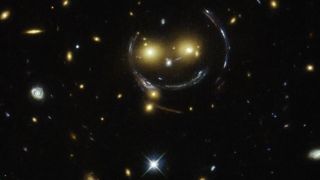Distortions in space-time could put Einstein's theory of relativity to the ultimate test
Observing time distortions could show whether Einstein's theory of general relativity accounts for the mysteries of dark matter and dark energy.

Scientists could soon test Einstein's theory of general relativity by measuring the distortion of time.
According to new research published June 22 in the journal Nature Astronomy, the newly proposed method turns the edge of space and time into a vast cosmic lab to investigate if general relativity can account for dark matter — a mysterious, invisible form of matter that can only be inferred by its gravitational influence on the universe's visible matter and energy — as well as the accelerating expansion of the universe due to dark energy. The method is ready to be tested on future surveys of the deep universe, according to the study authors.
Related: The expansion of the universe could be a mirage, new theoretical study suggests
General relativity states that gravity is the result of mass warping the fabric of space and time, which Einstein lumped into a four-dimensional entity called space-time. According to relativity, time passes more slowly close to a massive object than it does in a mass-less vacuum. This change in the passing of time is called time distortion.
Since its introduction in 1915, general relativity has been tested extensively and has become our best description of gravity on tremendous scales. But scientists aren't yet sure if it can explain invisible dark matter and dark energy, which together account for around 95% of the energy and matter in the universe.
"Time distortion predicted by general relativity has already been measured very precisely at small distances," Camille Bonvin, lead study author and an associate professor at the University of Geneva, told Live Science via email. "It has been measured for planes flying around the Earth, for stars in our galaxy, and also for clusters of galaxies. We propose a method to measure the distortion of time at very large distances."
The method suggests testing time distortion by measuring redshift, the change in the frequency of light an object emits as it moves away from us. Bonvin said the difference here is that this technique measures redshift caused as light attempts to climb out of a gravitational well, a "dent" in space-time created by a massive object.
"This climb changes the frequency of the light because time passes at different rates inside and outside of the gravitational well," she said. "As a consequence, the color of the light is changed; it is shifted to red. … By measuring gravitational redshift, we obtain a measurement of the distortion of time."

Time to test general relativity
Time distortion suggests that time is not absolute in our universe but rather passes at varying rates depending on gravitational fields.This idea is not exclusive to general relativity.
"Time distortion exists in all modern theories of gravity," Bonvin said. "However, the amplitude of the time distortion — how much the presence of a massive object slows down time — varies from theory to theory."
In general relativity, the distortions of time and space are predicted to be the same; in other theories of gravity, this is not always the case. That means that by measuring the distortion of time and comparing it to the distortion of space, physicists can test the validity of general relativity.
The team's new method could also test another leading theory of the cosmos: Euler's formula, which astronomers use to calculate the movement of galaxies. Specifically, the team's proposed measurement of time distortion could prove whether dark matter obeys Euler's equation, as prior studies of time distortion have presumed.
"We have never observed a particle of dark matter directly. We have only felt its presence gravitationally," Bonvin said. "As a consequence, we don't know if dark matter obeys the Euler equation. It may very well be that dark matter is affected by additional forces or interactions in our universe besides gravity. If this is the case, then dark matter will not obey the Euler equation."
The team's method could be employed by future missions, including the European Space Agency's Euclid telescope, which is set to launch in July, and the Dark Energy Spectroscopic Instrument, which is three years into its five-year survey of the universe.
"It will be possible to measure the distortion of time with the data delivered by these surveys," Bonvin said. "This is very interesting because, for the first time, we will be able to compare the distortion of time with that of space, to test if general relativity is valid, and we will also be able to compare the distortion of time with the velocity of galaxies, to see if Euler's equation is valid. With one new measurement, we will be able to test two fundamental laws."
Live Science newsletter
Stay up to date on the latest science news by signing up for our Essentials newsletter.
Robert Lea is a science journalist in the U.K. who specializes in science, space, physics, astronomy, astrophysics, cosmology, quantum mechanics and technology. Rob's articles have been published in Physics World, New Scientist, Astronomy Magazine, All About Space and ZME Science. He also writes about science communication for Elsevier and the European Journal of Physics. Rob holds a bachelor of science degree in physics and astronomy from the U.K.’s Open University
-
Debed Where are the protests?Reply
Wasn’t «Science» settled by consensus?
How dare they question settled «Science».
Most Popular
By Lou Mudge
By Lou Mudge